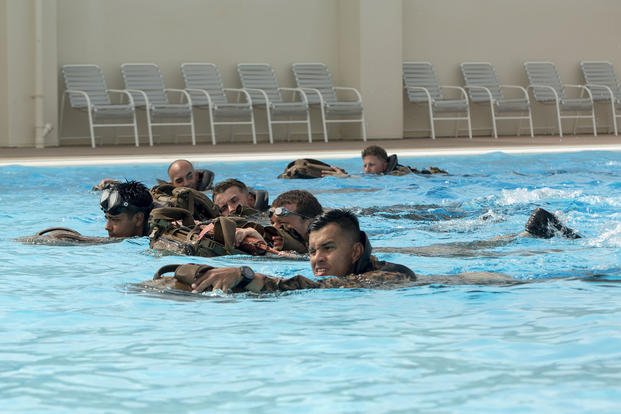Swimming is a tough sport to learn by yourself, but it is possible to view videos and self-teach some strokes and prepare properly for the military swimming tests.
It is no secret that you do not need to be a world-class or even a former competitive swimmer to join even the toughest swimming/diving training programs in the military (SEAL, SWCC, RECON, AF pararescue, diver, etc.). But you must be in swimming shape and competent in the water. Here is a question from a young man who is new to swimming and the combat swimmer stroke (CSS), which is used by many military special-ops programs.
Stew,
I just started with swimming and learning the CSS. I can swim 50 yards between 46-50 seconds. I currently swim for 5 minutes with rest and then do calisthenics and repeat it 5 times a few times a week. My question is, what workout should I do to build my lungs to swim 500 yards fast, and how long does it usually take?
Thanks for the help, Brad
Brad - that is not bad. Getting your 50-yard swim down to the 50-second zone is the first step. When you can do this easily with minimal effort (lower strokes per length -- 5-6 per 25 yards), you are efficient enough to be competitive with not only the swim but also have the energy for the remaining elements of the physical screening test (push-ups, sit-ups, pull-ups, 1.5-mile run).
Now you need to get in shape for the 500-meter swim. The following is a workout I would recommend doing 4-6 days a week to be able to swim a competitive score of 8:20 or less. The 8:20 is 500 seconds.
Swimming 500 yards in 500 seconds is easy math to figure out your pace during workouts. 100 yards = 100 seconds (1:40). 250 yards = 250 seconds (4:10). Easy math. Here is how to get in shape so you can maintain that pace for 500 yards.
- Swim 500-yard warmup. This is part mental and part conditioning. Every day we swim, we start off with a 500-yard warmup. This is done day after day, which will trigger a reaction in your brain (and body) that 500 yards is “just a warmup.” This is a great way to reframe what used to be a distance that was difficult to finish without resting. Eventually, it will come. After the 500-yard warmup swim, this can be a combination of strokes:
Repeat 10 times
-- 50-yard freestyle fast (get winded)
-- 50-yard CSS at goal pace (one yard per second or 50 seconds, for instance)
As you start to improve, this workout will become too easy. Now it is time to increase the distances of the CSS portion. Increase to 100 yards, then 150 and even 200-250 yards. You can decrease the number of overall sets repeated if you are short on time. You really only need to swim 1,500-2,000 yards, maximum, to prepare for the 500-yard swim test.
Rest with swim skills/PT events. One great way to add in other elements you must master in the water is to rest one minute between these sets but rest with treading (no hands). Rest with drownproofing elements and other events that you know you will see again in your future training.
You also can rest with PT events on the pool deck like push-ups, plank poses, squats, lunges, bear crawls, flutter kicks and other core exercises between sets to help with muscle stamina in the PT test.
Give yourself time to get good at swimming, running, rucking, lifting, and high repetition calisthenics before entering the military (related article). This may take up to a year or more to be in the type of conditioning so that the demands of the physical screening test and the following selection training (BUD/S) will not crush you. Patience, hard work and consistent effort will get you there.
Eventually, you will need to build up to 1,500 meters of swimming in your workouts to be fully prepared for a fast/competitive 500-yard CSS swim for the Navy. I would swim at least five days a week to get into swimming shape.
Stew Smith is a former Navy SEAL and fitness author certified as a Strength and Conditioning Specialist (CSCS) with the National Strength and Conditioning Association. Visit his Fitness eBook store if you’re looking to start a workout program to create a healthy lifestyle. Send your fitness questions to stew@stewsmith.com.
Want to Learn More About Military Life?
Whether you're thinking of joining the military, looking for fitness and basic training tips, or keeping up with military life and benefits, Military.com has you covered. Subscribe to Military.com to have military news, updates and resources delivered directly to your inbox.















